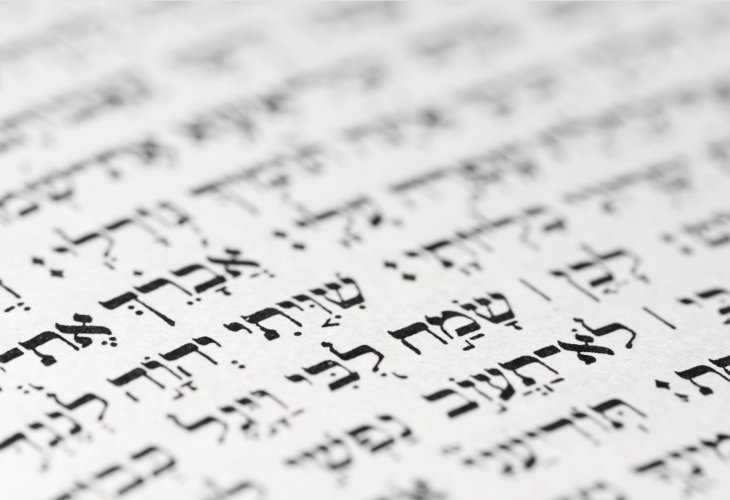Roots of Words: The Meaning of Hebrew Letter Clusters
Roots of words have unique meanings. Each root can express positivity or negativity.
 (Photo: Shutterstock)
(Photo: Shutterstock)The oldest book among the esoteric teachings dealing with the secrets of the letters is "Sefer Yetzirah" attributed to Abraham our father. The secrets in this book were secretly passed down from generation to generation due to the power of the creation codes within, until they were recorded in a cryptic language during the Mishnah period. This was the difficult period after the destruction of the Second Temple, when the main teachings of the Oral Torah were written to prevent their loss during the upheavals of exile.
Sefer Yetzirah describes in an obscure language the formation of all creation's details through the combinations of letters (with their appropriate intentions), creating sacred names and higher forces (for a comprehensive look at Sefer Yetzirah, see the introduction).
Here is the language of "Sefer Yetzirah" regarding the essence of the letters:
"Twenty-two letters: He engraved them, carved them, weighed them, and exchanged them. He combined them and with them formed the soul of all creation and the soul of all that would be created."
"Engraving" means determining their shape, like a person engraving a basic shape in stone. However, here it refers to spiritual engraving. "Carving" involves separating each letter with all that it conceals, like carving from stone. "Weighing," he examined each according to its nature and placed it according to its action in the order of the letters (Hebrew linguists are puzzled about the reason for the order of the letters. However, for those studying the secret of the letters, the order is understood and necessary as explained below). "Exchanging," he gave them the possibility of exchange and substitution between parallel letters, like the At-Bash, Alb"m, and others. This exchange also included the possibility of changing the root action of each letter itself from positive to negative, as well as changing a word from positive to negative by altering the position of its letters, as stated at the end of the following mishnah:
"Twenty-two foundational letters, fixed in a cycle in 231 gates, and the cycle returns front and back. And this is a sign for the matter: there is nothing better than 'oneg' and nothing worse than 'nega'."
Delight versus Plague
The language of Hebrew is unique because its roots are built on the foundation: "Hashem made this opposite that." That is, its words are constructed such that an arrangement of letters in one order creates a positive meaning, while a different arrangement of the same letters creates the opposite, negative meaning. Likewise, in all creation, the positive and negative were created opposite each other to allow the principle of free choice. For example, if the forces of holiness were the only means to alter nature and perform miracles, human free choice would be impaired. Therefore, the ability was also given to the forces of the sitra achra to control nature and perform miracles, such as through witchcraft, as told in the Torah regarding the abilities of the magicians of Egypt and others. Only in this way does a person face worldly trials with a proper balance of good versus evil, enabling them to freely choose the path of good, thereby elevating their spiritual level to receive reward deservedly.
And so it is with words. Every cluster of letters that makes up a word has a combination with a positive meaning - like "oneg" (delight), and there is a combination with a negative meaning - like "nega" (plague). A person is required to adopt and apply in their life the combination with the positive meaning for their benefit (and see a deep explanation of "oneg" versus "nega" in my books "Journey to the Truth," based on the verse "A river flowed out of Eden to water the garden").
So too, for example, "nachash" means enchantment and knowledge of the hidden in a negative way, as the verse says: "For there is no divination in Jacob." Conversely, through the "choshen" Israel knew the hidden in a holy way. This fundamental change in the word is due to one difference: the bent letter 'nun' in "nachash" straightens and becomes an upright ‘nun’, the corrected letter 'nun', which like all final letters hints to the end, to the days of the Messiah, when the world will reach its rectification.
Here are other examples:
To praise (lekales), means to honor. In contrast: to mock and scorn.
To take root (lehashrish), means to connect. In contrast: to uproot (lesharesh).
To create (livro), means to bring into existence. In contrast: to shave, to remove (livra).
Weak (chalash), means below someone. In contrast: rules (choresh), above someone.
Proud (ga'eh), above. In contrast: valley (gai), below.
Holiness (kedusha), high separation. In contrast: harlot (kadesha), low debauchery.
Friend (rei), a loving person who seeks the good of others. In contrast: evil (ra), one who wishes harm upon others.
Noticeable (nikar), means felt. In contrast: ignores (mitnaker), disregards.
Poor (dal), means low and weak. In contrast: high (dolei).
Gives (gomel), grants. In contrast: weaned (nigmal), detached from receiving.
And many more.
*
This principle exists in many words also from the aspect of their numeric value (gematria) of opposite words of equivalent gematria.
For example, "nachash" symbolizes the evil inclination, the ancient serpent that brought impurity to the world by causing Adam and Eve to sin. In contrast, the "Mashiach" will rectify the world with the Kingdom of Shaddai and bring about the cleansing and removal of the stain of Adam's sin from the world. And both have the same gematria.
Needless to say, this marvelous phenomenon is unique to the Holy Tongue and has no equal in any language in the world.
To purchase Rabbi Zamir Cohen's book "The Code," visit Hidabroot Shops.

